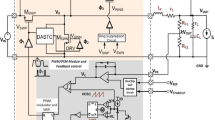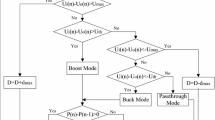Abstract
IoT and wearable medical devices frequently require ultra-low power solutions that can support long spells of inactivity. This study presents a buck converter to control power stages using a novel pulse frequency modulation (PFM) system that reduces switching losses for low-power systems. The modulation of high and low-frequencies was demonstrated, where the high-frequencies exhibited better energy transformation between the inductor and capacitor, and the low-frequencies could be adjusted for different current loads, to reduce switching losses. This circuit is optimized for light load applications. Using voltage control oscillation (VCO), the frequency range of 0.5 MHz – 2.0 MHz can be adjusted to influence conversion efficiency for different loads. The design was simulated and then fabricated using TSMC 0.18um process. The core size was about 1500 × 1000um that includes power MOS. Measurements result an average conversion efficiency of 91% under a load of 0.1 mA – 10 mA. This chip is suitable for battery-based IoT systems, or wearable medical devices.
















Similar content being viewed by others
Data availability
Raw data were generated at the VLSI lab. in Department of Electronics Engineering, National Yunlin University of Science and Technology.
References
Zeng, W. L., Ren, Y., Lam, C.-S., Sin, S. W., Che, W. K., Ding, R., & Martins, R. P. (2020). A 470-nA Quiescent current and 92. 7%/94 7% efficiency DCT/PWM control buck converter with seamless mode selection for IoT application. IEEE Trans. Circuits Syst. I Reg. Papers, 67, 4085–4098.
Park, Y.-J., et al. (2017). A design of a 92.4% efficiency triple mode control DC–DC buck converter with low power retention mode and adaptive zero current detector for IoT/Wearable applications. IEEE Transactions on Power Electronics, 32(9), 6946–6960.
J. Yu, S. Jeon, H. Choi, N. Kim, “CMOS Integrated PFM DC-DC Converter with Digitally-Controlled Frequency Selector”, in 2019 IEEE 23rd Workshop on Signal and Power Integrity (SPI), June 2019
S.H. Park, K.T. Kim, K.Y. Lee, “Buck DC-DC converter with PFM/PWM dual mode self-tracking zero current detector”, in 2017 International SoC Design Conference (ISOCC), Nov. 2017
Kim, S. Y., et al. (2018). A design of a high efficiency DC–DC buck converter with two-step digital PWM and low power self-tracking zero current detector for IoT applications”. IEEE Transactions on Power Electronics, 33, 1428–1439.
Santoro, F., et al. (2018). A hysteretic buck converter with 92.1% maximum efficiency designed for ultra-low power and fast wake-up SoC applications. IEEE Journal of Solid-State Circuits, 53, 1856–1868.
Zhao, M., Li, M., Song, S., Hu, Y., Yao, Y., Bai, X., Hu, R., Wu, X., & Tan, Z. (2022). An ultra-low quiescent current tri-mode DC-DC buck converter with 92.1% peak efficiency for iot applications. IEEE Trans. Circuits Syst. I Reg. Papers, 69, 428–439.
Shafiee, N., Tewari, S., Calhoun, B., & Shrivastava, A. (2017). Infrastructure circuits for lifetime improvement of ultra-low power IoT devices. IEEE Trans. Circuits Syst. I Reg. Papers, 64, 2598–2610.
Shi, C., Duncan, J., Pu, Y., Liu, G., Homayoun, A., & Attar, R. (2018). An ultralow-power on-die PMU in a 28-nm CMOS SoC with direct Li-Ion battery-attach capability. IEEE J. Emerg. Selected Topics Power Electron., 6, 465–476.
Şahin, M. E., & Blaabjerg, F. (2021). An overview on MOSFET drivers and converter applications. Electric. Power Components Syst., 49(8), 828–847.
Kim, J. S., Yoon, J. O., & Choi, B. D. (2022). A high-light-load-efficiency low-ripple-voltage PFM buck converter for IoT applications”. IEEE Transactions on Power Electronics, 37, 5763–5772.
LiouMLYehYLKuo, W. R. (2008). A high efficiency dual-mode buck converter IC for portable applications. IEEE Transactions on Power Electronics, 23(2), 667–677.
Cheng, L., Lai, X., & Shi, L. (2015). Low-quiescent-current flexible mode buck–boost converter. IET Power Electron., 8(12), 2520–2528.
Hong, W., & Lee, M. (2020). A 7 4-MHz tri-mode DC-DC buck converter with load current prediction scheme and seamless mode transition for IoT applications. IEEE Trans. Circuits Syst. I Reg. Papers, 67, 4544–4555.
Chen, P.-H., Wu, C.-S., & Lin, K.-C. (2016). A 50 nW-to-10 mW output power tri-mode digital buck converter with self-tracking zero current detection for photovoltaic energy harvesting. IEEE Journal of Solid-State Circuits, 51(2), 523–532.
Jiang, Y., Law, M.-K., Chen, Z., Mak, P.-I., & Martins, R. P. (2019). Algebraic series-parallel-based switched-capacitor DC–DC boost converter with wide input voltage range and enhanced power density. IEEE Journal of Solid-State Circuits, 54(11), 3118–3134.
Zhang, S., Zhao, M., Wu, X., & Zhang, H. (2018). Dual-phase DC–DC buck converter with light-load performance enhancement for portable applications. IET Power Electron., 11(4), 719–726.
Chen, P.-H., Cheng, H.-C., Ai, Y.-A., & Chung, W.-T. (2018). Automatic mode selected energy harvesting interface with >80% power efficiency over 200 nW to 10 mW. IEEE Transactions on Very Large Scale Integration (VLSI) Systems, 26, 2898–2906.
Radfar, M., Nakhlestani, A., Viet, H. L., & Desai, A. (2020). Battery management technique to reduce standby energy consumption in ultra-low power IoT and sensory applications. IEEE Trans. Circuits Syst. I Reg. Papers, 67, 336–345.
Kim, S. J., Choi, W. S., Podgurski, R. P., & Hanumolu, P. K. (2018). A 10-MHz 2–800-mA 0. 5–1.5-V 90%peak efficiency time-based buck converter with seamless transition between PWM/PFM modes”. IEEE Journal of Solid-State Circuits, 53, 814–824.
N. Beohar et. al. A digitally controlled DC-DC buck converter with automatic digital PFM to PWM Transition Scheme,” 2021 IEEE Applied Power Electronics Conference and Exposition (APEC), pp.517–522
Liou, W. R., Yeh, M. L., & Kuo, Y. L. (2008). A high efficiency dual-mode buck converter IC for portable applications. IEEE Transactions on Power Electronics, 23(2), 667–677.
Şahin, M. E., Okumuş, H. İ, & Aydemir, M. T. (2014). Implementation of an electrolysis system with DC/DC synchronous buck converter. International Journal of Hydrogen Energy, 39(13), 6802–6812.
Aden, I. A., Kahveci, H., & Şahin, M. E. (2021). Design and Implementation of single-input multiple-output DC–DC buck converter for electric vehicles. J. Circuits, Syst. Comput., 30(13), 2150228.
Shi, C., Walker, B. C., Zeisel, E., Hu, B., & McAllister, G. H. (2007). A highly integrated power management IC for advanced mobile applications. IEEE Journal of Solid-State Circuits, 42(8), 1723–1731.
F. Yasmin, A.Basak, M. Mahin, M. T. Amin, “MOS Capacitance Based 3-Stage Current Starved Ring VCO for Wireless Applications”, In 2019 International Conference on Electrical, Computer and Communication Engineering (ECCE), Feb. 2019
M. Rashid, power electronic handbooks, 4th edition, 2018.
Author information
Authors and Affiliations
Contributions
1. Phd. Hsia : circuit design and paper writer 2. Mr. Hsieh: simulation and chip layout
Corresponding author
Ethics declarations
Competing interests
The authors declare no competing interests.
Conflict of interest
I declare that the authors have no competing interests as defined by Springer.
Additional information
Publisher's Note
Springer Nature remains neutral with regard to jurisdictional claims in published maps and institutional affiliations.
Rights and permissions
Springer Nature or its licensor (e.g. a society or other partner) holds exclusive rights to this article under a publishing agreement with the author(s) or other rightsholder(s); author self-archiving of the accepted manuscript version of this article is solely governed by the terms of such publishing agreement and applicable law.
About this article
Cite this article
Hsia, SC., Hsieh, MJ. Chip implementation of low-power high-efficient buck converter for battery-powered IOT applications. Analog Integr Circ Sig Process 118, 437–448 (2024). https://doi.org/10.1007/s10470-023-02204-5
Received:
Revised:
Accepted:
Published:
Issue Date:
DOI: https://doi.org/10.1007/s10470-023-02204-5




